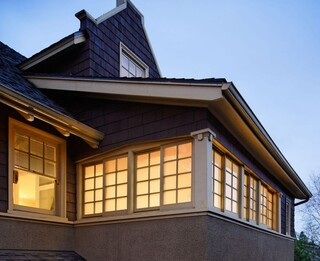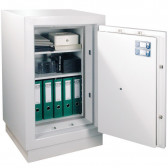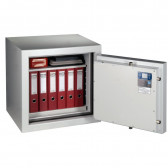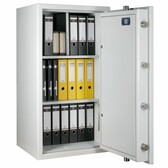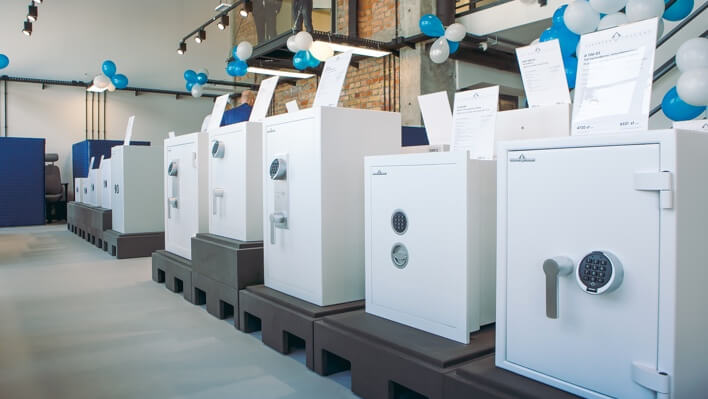Installing a safe in your house or office is an important decision that requires proper planning and preparation. The safe should be placed in a location that offers optimum protection against burglary, fire, flooding or other hazards.We will guide you through the subject of this article.
Types of safes used in a house
If you are concerned about the security of your possessions at home, want to hide precious things, cash, storage media, documents that are important to you, or perhaps need a place to store weapons, then a home safe is an excellent idea. Selecting the right safe allows you to have just the amount of secure storage space you need, perfectly tailored to your personal requirements. There are 3 main product categories to choose from:
Free-standing safes
By far the most secure, the heaviest safes, having the highest security ratings. They allow you to place them in various places within your flat or house according to your convenience and security needs. A free-standing safe is assembled by screwing it to the floor and/or wall with a steel screw. Their robust construction and heavy weight make them difficult to remove. Additionally, free-standing safes often come with customizable interiors, enabling you to organize valuables, papers, and other items efficiently.
There is the widest choice among various resistance grades, weights and dimensions in this category, with fireproof series also available. You surely will find the adequate safe for your work place, house or flat. If you then will seek for a possibility to carry your safe just bought, feel free to contact us for support.
Wall safes
This is a safe that is installed in a suitable recess in the wall that has been prepared in advance. Installation of a wall safe involves masonry work. In this category, the maximum is class I in accordance with the EN 1143-1 standard, and it is not possible to make a wall safe which has a fire-resistance class.
Wall safes are a good choice when you want to make better use of the available room in your house. They are installed directly into the wall, which means they do not take up any floor space, making them ideal for smaller rooms or apartments. When moving to another city, a safe remains fixed in place, so you don't have to worry about transporting the strongbox. It is important to carefully choose the right spot in your house to ensure both security and accessibility, but overall, this category of safes offers a smart and practical solution for protecting your precious and important items.
You will find important information about these sort of safes in the text "Wall safe – everything you need to know about it".
Floor safes
These are similar to small furniture safes, however, the safe is inserted into a pre-prepared hole in the floor, and the opening method "from above" is facilitated by hydraulic aids.
Before buying a safe, it is worth looking around for a place to install the safe at home, so that, on the one hand, a thief cannot get at your precious items, and on the other hand, to hide the safe from casual visitors; finally, so that the assembly of a safe does not have to be accompanied by a revolution in your life and personal space.
Installation is important – further secure your new home safe against theft
A burglar-proof safe is generally designed to protect money, important documents or jewellery from theft. If you are thinking of buying a safe, pay attention to three fundamental factors that make up the overall level of protection.
The security grade of the safe
Briefly reflects how long it takes to drill through the body. The higher the burglary resistance class, the longer the process takes. A burglary generally takes a few minutes or so, therefore it is important that the safe cannot be accessed at a walk-in. You will find safes from class S1 according to EN 14450 (the lowest) to class V according to EN 1143-1 (the highest) in our range.
The security grade also indicates the safe's ability to withstand different types of attacks, such as drilling, prying, or cutting. Choosing a safe with a higher security grade is essential if you want to protect especially valuable or sensitive items. Keep in mind that insurance companies often require a minimum security grade for certain valuables to provide coverage.
Take a look at our guide through the burglary resistance grades!
Fire resistance level
Expressed in minutes, this indicates the time range over which a safe exposed to prolonged exposure to high temperatures will maintain a moderate internal temperature. 30-, 60- and 120-minute classes are available in accordance with EN 1047-1.
The weight of the safe
Derived directly from the burglary and fire resistance class: the higher the class, the heavier the safes are. This is of great importance because if a burglar takes the safe out, the entire contents will be lost.
Assembly of the safe as a complement to the other parameters
Here are some factors to consider when choosing a place for a safe:
The security level of the safe
The safe should be fixed to a wall or floor with special screws or anchors to prevent it from being moved or balanced. It also should be hidden from unauthorised view, such as behind a painting, a piece of furniture or in a cupboard.
Accessibility to the safe
The safe should be easily accessible to the owner or authorised persons, but at the same time difficult to locate for potential burglars. It is advisable to place it in a location that is frequently visited by the owner or authorised persons, such as a bedroom, study or living room.
Environmental conditions
The safe should be protected from moisture, temperature and other factors that could damage its contents or mechanism. The safe should be placed in a dry place with good ventilation and a stable temperature; it should rather not be placed in a bathroom, kitchen, basement or garage.
Is it worth anchoring large safes with heavy weight?
Not only is it worth it, but you actually have to mount the safe to the structural elements of the building. Firstly, according to European EN 1143-1 standard, physical mounting of the safe is necessary for any safe weighing less than 1,000 kg, a weight rarely found in safes on the civilian market. Secondly, permanently mounting the safe by drilling into the floor or load-bearing wall significantly reduces the risk of the safe, even a heavy one, being carried away. We know of cases in the industry where safes weighing up to several hundred kilograms have been taken away from the scene of a burglary, so any way of improving security is worth considering.
How do you conceal a safe in your house effectively?
One of the popular questions regarding the dilemma of where to put a safe in a house is: how do you conceal a safe from a burglar? Hiding a safe can indeed be an element in reducing the risk of theft, provided, however, that it does not force you to compromise being too rotten. Wall safes have their advantages, but remember that such a safe will always be objectively weaker than a similar sized free-standing safe in the same burglary rating. So if concealing a safe in your house or flat is a priority, consider freestanding safes first when planning your purchase.
When choosing where you want to install the safe in your home, consider that the fewer people around you who know about the safe, the better. Therefore, if strangers frequent your home, take care to place it where it will not be conspicuous.
There are several places where you can comfortably hide a safe, these are primarily rooms that are intimate to you on a daily basis, such as a dressing room or bedroom, which you would rather not allow outsiders into. You can also place the safe in the study. By locating the safe in a built-in piece of furniture, you can easily hide it from your visitors.
Where does a thief usually look?
Exactly where you do. A thief looks in places where he would conceal a safe himself, so even placing a safe in the most ingenious location of a house or flat does not guarantee 100% that it has been successfully hidden.
You can therefore be sure that all places in your home where you could hide a safe will be thoroughly checked: wardrobes in bedrooms, dressing rooms, studies, basements and garages. Concealing a safe ‘for good’ is obviously at odds with its everyday use. A safe at home is usually used to store weapons, documents, precious things and money, i.e. items that you want to have easy access to.
Mounting the safe in a wall
However, if, having weighed up all the pros and cons, you are planning to buy a wall-mounted safe, it is worth looking into. A wall safe differs from free-standing models in that its interior is defended by a door with concealed hinges allowing the front to remain flat. When choosing a wall-mounted safe, you need to choose a wall of suitable thickness.
You can read more about this in the article "A safe to be built into the wall".
Floor-mounted furniture safe
Floor-mounted safes are a secure variant. In principle, this works more as a locker than a real safe. In fact, the safe is then built into the floor, and it can also be covered with panels to hide it successfully, but bear in mind that easy access to a safe installed in this way will not be possible.
FAQ: Where is the best place to put a gun safe in your house?
Summary
When deciding where to put a gun safe in your house, it's crucial to find the right place that offers both security and convenience. Look for a space that is discreet yet easily accessible for you.
Integrating the weapon safe into existing furniture can be an effective way to conceal it while optimizing room layout, especially if you only need to store handguns. Choosing the right spot ensures your firearms are stored safely without compromising the functionality of your living space.
Placing a safe in the house is not an easy story. You can put it in your home in a variety of non-obvious locations; however, remember that the security class of the safe, its weight, the degree of fire resistance and professional installation will determine whether your precious things will be secured in the first place, and only finally the location itself. Please remember: you can find safes with highest security ratings in the product range of HARTMANN TRESORE. A thief will look for safes until he finds one, and he will find one with a high probability. Our job is to ensure that what you keep in the safe does not fall into his hands. If you have any questions or concerns – we are here to guide and support you by choosing the right product!
